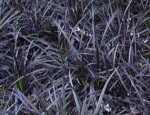 When I first saw this plant over ten years ago I was thrilled by its unique look: black leaves. Of course there really are no truly black leaves in nature but these leaves are about as black as you can get. I brought my treasure home and planted it along a shaded pathway thinking that it would spread rapidly and form a nice edging along the brick walkway. Wrong! It stayed in its small round clump for the whole year and a bit more. Worse yet in blended in with the dark mulch I had spread to conserve moisture for the foamflowers (Tiarella cordifolia) and hosta that I had planted in the area. Worst of all when it eventually did form some new clumps there seemed to be a significant number of green leaves in them. Well, the problem was that I didn’t know much about black mondo grass and how best to show it off. True, it is slow growing. It spreads by rhizomes and won’t become invasive even in the moist environment it loves. The new growth often has a green tinge but the leaves usually turn to black and if they don’t the green ones can be easily snipped out. As a bonus, small flowers are produced in summer followed by glossy purple fruit. In order to show off the plant to its full advantage it should be put next to something that contrasts with light green, chartreuse, or gold foliage. I found a small round-leaf chartreuse hosta as companion for my black mondo grass and the two-some glowed in each other’s company. Long after the hosta went to bed for the winter the black mondo grass graced the site, adding a subtle texture and color to the garden that was otherwise sleeping.
When I first saw this plant over ten years ago I was thrilled by its unique look: black leaves. Of course there really are no truly black leaves in nature but these leaves are about as black as you can get. I brought my treasure home and planted it along a shaded pathway thinking that it would spread rapidly and form a nice edging along the brick walkway. Wrong! It stayed in its small round clump for the whole year and a bit more. Worse yet in blended in with the dark mulch I had spread to conserve moisture for the foamflowers (Tiarella cordifolia) and hosta that I had planted in the area. Worst of all when it eventually did form some new clumps there seemed to be a significant number of green leaves in them. Well, the problem was that I didn’t know much about black mondo grass and how best to show it off. True, it is slow growing. It spreads by rhizomes and won’t become invasive even in the moist environment it loves. The new growth often has a green tinge but the leaves usually turn to black and if they don’t the green ones can be easily snipped out. As a bonus, small flowers are produced in summer followed by glossy purple fruit. In order to show off the plant to its full advantage it should be put next to something that contrasts with light green, chartreuse, or gold foliage. I found a small round-leaf chartreuse hosta as companion for my black mondo grass and the two-some glowed in each other’s company. Long after the hosta went to bed for the winter the black mondo grass graced the site, adding a subtle texture and color to the garden that was otherwise sleeping.
Type: Herbaceous perennial (evergreen in warm climates).
Bloom: Small pink, lavender or white flowers in summer.
Size: 8-12” H x 8-12” W.
Light: Full sun to part shade.
Soil: Fertile, consistently moist, well-drained.
Hardiness: Zones 7-9.
Pests and Diseases: Slugs and snails can be a problem.
Propagation: Division; seed (but germination is 6 weeks and seed should be soaked before sowing)
Companion plants: Light green, chartreuse, gold foliage plants such as foamflower (Tiarella cordifolia), some hostas, and some heucheras ( like “Lime Rickey’); bugelweed (Ajuga spp.); creeping jenny (Lysamachia nummularia)
